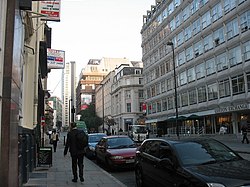Liverpool Cotton Exchange Building
| Liverpool Cotton Exchange Building | |
|---|---|
 Liverpool Cotton Exchange Building, Old Hall Street front | |
| Location | Old Hall Street, Liverpool, Merseyside, England |
| OS grid reference | SJ 341 908 |
| Built | 1905–06 |
| Built for | Liverpool Cotton Exchange |
| Restored | 1967–69 |
| Architect | Matear and Simon, Newton-Dawson, Forbes and Tate |
Listed Building – Grade II | |
| Designated | 14 March 1975 |
| Reference no. | 1363092 |
Liverpool Cotton Exchange Building is an office block in Old Hall Street, Liverpool, Merseyside, England. It was built in 1905–06 to replace the former cotton exchange in Exchange Flags. Its Neoclassical façade was replaced in 1967–69 by one in more modern design. The building is used mainly as offices, with some retail facilities.
History
The business of the cotton exchange was originally conducted outdoors on Exchange Flags, behind Liverpool Town Hall. The first Cotton Exchange Building was built in 1808 adjacent to the flags.[1] The present building in Old Hall Street was erected in 1905–06 to a design by Matear and Simon. Its façade was in Neoclassical style, with Baroque towers at the angles.[2] Its exterior decoration included statues. Inside the building was the latest technology for communicating with cotton trading elsewhere in the world, including telephones, and cables linking directly with New York, Bremen and Bombay.[3] The Old Hall Street front was replaced with a modern-style façade designed by Newton-Dawson, Forbes and Tate in 1967–69, and the former main exchange hall was replaced by a courtyard.[2] In addition to offices, the building also incorporates retail facilities.[3]
Architecture
The building is in seven storeys, and the modern front on Old Hall Street, facing southwest, has 21 bays. The sides and back of the building are largely unaltered from the original design. The façade on Edmund Street, facing northwest, has retained cast iron panels decorated with wreaths, made by Macfarlane's of Glasgow. The back of the building, on Bixteth Street, is faced with Portland stone, and the Ormond Street front is in brick. Inside the building the colonnade formerly surrounding the trading floor is still present. The columns are monoliths of larvikite, quarried in Norway and polished in Aberdeen.[2] The building is designated by English Heritage as a Grade II listed building.[4] Some of the statues formerly on the façade are now located nearby; these include personifications of Navigation and Commerce.[3]
See also
References
- ^ A city built on cotton, National Museums Liverpool, archived from the original on 13 November 2012, retrieved 23 March 2013
- ^ a b c Sharples, Joseph; Pollard, Richard (2004), Liverpool, Pevsner Architectural Guides, New Haven and London: Yale University Press, p. 159, ISBN 0-300-10258-5
- ^ a b c The Cotton Exchange, Bruntwood, retrieved 20 August 2011
- ^ Historic England. "Cotton Exchange Building, Liverpool (1363092)". National Heritage List for England. Retrieved 29 August 2012.
{{cite web}}: Check date values in:|access-date=(help); Unknown parameter|separator=ignored (help)





